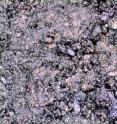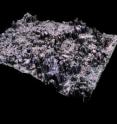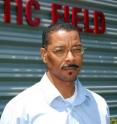Magnet lab research suggests novel superconductor
Related images
(click to enlarge)
Superconductivity has perplexed, astounded and inspired scientists ever since it was discovered in 1911. Now, in the latest of a century of surprises, researchers at the National High Magnetic Field Laboratory at Florida State University have discovered unusual properties in a novel superconducting material that point to an entirely new kind of superconductor. Frank Hunte, a postdoctoral associate at the lab's Applied Superconductivity Center (ASC), working with David Larbalestier, Alex Gurevich and Jan Jaroszynski, and colleagues in David Mandrus' group at Oak Ridge National Laboratory in Tennessee, discovered surprising magnetic properties in the new superconductors that suggest they may have very powerful applications Ñ from improved MRI machines and research magnets to a new generation of superconducting electric motors, generators and power transmission lines. The research also adds to the long list of mysteries surrounding superconductivity, providing evidence that the new materials, which scientists are calling "doped rare earth iron oxyarsenides," develop superconductivity in quite a new way, as detailed in the latest issue of the prestigious journal Nature.
Though research on this substance is very much in its early stages, scientists are talking excitedly of "promise" and "potential."
"What one would like is a greater selection of superconductors, operating at higher temperatures, being cheaper, possibly being more capable of being made into round wires," said Larbalestier, director of the ASC. "Iron and arsenic, both inherently cheap materials, are key constituents of this totally new class of superconductors. We're just fascinated. It's superconductivity in places you never thought of."
Superconductivity can be thought of as "frictionless" electricity. In conventional electricity, heat is generated by friction as electrons (electric charge carriers) collide with atoms and impurities in the wire. This heating effect is good for appliances such as toasters or irons, but not so good for most other applications that use electricity. In superconductors, however, electrons glide unimpeded between atoms without friction. If scientists and engineers ever harness this phenomenon at or near room temperature in a practical way, untold billions of dollars could be saved on energy costs.
That's a big if. Superconductivity, though promising, is still impractical in routine engineering use because it requires a very cold environment attainable only with the help of expensive cryogens such as liquid helium or liquid nitrogen. Past discoveries have helped scientists inch their way up the thermometer, from superconductors requiring minus 452 degrees Fahrenheit (or 4.2 Kelvin) to newer materials that superconduct at around minus 200 degrees F (138 K) Ñ still frigid, but substantially warmer and more practical.
Early this year, Japanese scientists who had been developing iron-based superconducting compounds for several years finally tweaked the recipe just right with a pinch of arsenic. The result: a superconductor, also featuring oxygen and the rare earth element lanthanum, performing at a promising minus 413 degrees F (26 K). The presence of iron in the material was another scientific stunner: Because it's ferromagnetic, iron stays magnetized after exposure to a magnetic field, and any current generates such a field. As a rule, magnetism's effect on superconductivity is not to enhance it, but to kill it.
Teams of scientists quickly got busy synthesizing and studying various iron oxyarsenides. Larbalestier, eager to get in on the research, secured a sample from colleagues at Oak Ridge. His objective: Put it in the magnet lab's 45-tesla Hybrid magnet to see how high a magnetic field the new material could tolerate. (Tesla is a unit of magnetic field strength; the Earth's magnetic field is one twenty thousandth of a tesla.)
Hunte and his colleagues thought the world-record Hybrid magnet would be more than sufficient to test the field tolerance limits of the new material. They thought wrong: The iron oxyarsenide kept superconducting all the way up to 45 tesla, far past the point at which other superconductors become normal conductors.
A high tolerance for magnetic field is one of three key properties researchers hope for in superconductors. Also desirable are the abilities to operate at relatively high temperatures and in the presence of high electrical currents. Superconductors are used to make MRI and research magnets, and now they are being tested in a new generation of superconducting electric motors, generators, transformers and power transmission lines. Today, the most powerful superconducting magnet generates a field of about 26 tesla. If a superconductor could be found that tolerates a higher current and field, it may make possible more powerful magnets, opening up vast new research areas to scientists and power applications.
Hunte's experiment yielded other tantalizing findings. Although scientists discovered half a century ago that superconducting electrons enter the "Cooper pair" state, pairing with opposite spin and momentum, magnetism was always thought to break such pairs. Now the archetypal magnetic atom, iron, is a key part of this new class of high temperature superconductors. Scientists have yet another puzzle to probe.
"So far," said Hunte, "based on both theoretical calculations and what we're seeing from the experiments, it seems likely that this is a completely different mechanism for superconductivity."
Hunte is quick to say the group's research barely scratches the surface.
"The field is completely open. No one knows where this is going to go," Hunte said. "If it's found that these materials can support high current densities, then they could be tremendously useful."
Source: Florida State University
Articles on the same topic
- New superconductors present new mysteries, possibilitiesWed, 4 Jun 2008, 19:21:49 UTC
- Getting warmer: UT Knoxville researchers uncover information on new superconductorsWed, 28 May 2008, 17:28:51 UTC
- New iron-based and copper-oxide high-temperatureWed, 28 May 2008, 17:28:43 UTC
Other sources
- New Superconductors Present New Mysteries, Possibilitiesfrom Science DailyThu, 5 Jun 2008, 0:35:40 UTC
- New Superconductors Present New Mysteries, Possibilitiesfrom Newswise - ScinewsWed, 4 Jun 2008, 20:28:15 UTC
- New superconductors present new mysteries, possibilitiesfrom PhysorgWed, 4 Jun 2008, 20:07:39 UTC
- Study might lead to novel superconductorsfrom UPIMon, 2 Jun 2008, 16:21:25 UTC
- New High-Temperature Superconductors Are Iron-based With Unusual Magnetic Propertiesfrom Science DailySun, 1 Jun 2008, 4:21:16 UTC
- Magnet Lab Research Suggests Novel Superconductorfrom Science DailyThu, 29 May 2008, 14:14:22 UTC
- Powerful Superconductor in a Class All Its Ownfrom Newswise - ScinewsWed, 28 May 2008, 20:28:15 UTC
- New Iron-based and Copper-Oxide High-Temperature Superconductors Share Key Magnetic Propertiesfrom PhysorgWed, 28 May 2008, 17:49:09 UTC
- New Iron-based and Copper-Oxide High Temperature Superconductors Share Key Magnetic Propertiesfrom Newswise - ScinewsWed, 28 May 2008, 17:28:15 UTC


